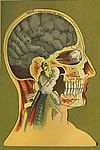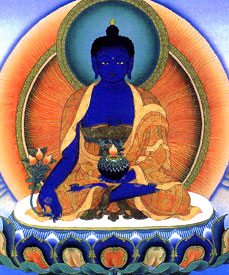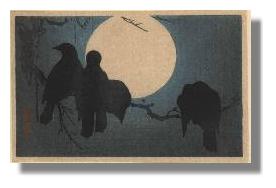A Journey Through the Senses
This six-star spa employs a concept that embodies ancient healing traditions
and mystic rituals of China and the Himalayas
KANOKPORN CHANASONGKRAM
Bangkok Post, Friday 29 July 2005
I've never been to Tibet, never climbed the Himalayas and the closest
I got
to the roof of the world was when I watched Tomb Raider. Recently though,
at
Shangri-La Hotel Bangkok I did find myself in a situation not unlike
a Lara
Croft adventure.
The dramatic light spilling through the lattice screen washing down
a
split-face stone wall, the Himalayan artifacts, the smell of scented
incense
and aromatic oils, the sound of singing bowls _ what was I doing in
a
Tibetan temple? It was a state of mind of course, and Chi The Spa at
Shangri-La was about to take me on a rejuvenating journey.
Matching the mystical ambience, this six-star spa employs a concept
that
embodies ancient healing traditions, philosophies, and rituals of China
and
the Himalayas. It's a health spa that believes in chi _ the universal
life
force that governs well-being and vitality.
Arlene Finch, the spa director, explained that to maintain
good health chi
must flow freely within the body. If blocked, it is likely that
illness will
occur; and to clear natural blockages, movement is a key element.
Combining
the physical movements of exercise, stretching, massage and hydrotherapy
with movement of the mind through relaxation and meditation will
help
release the chi energy and assist the body's natural renewal.
In addition, the treatments and product range are designed according
to the
Five Elements theory _ a Chinese philosophy that identifies the elements
metal, water, wood, fire, and earth which influence the chi energy.
Chi's
therapies aim to achieve a balance of the five elements to harmonise
with
the positive yang and negative yin energy within the body.
To identify my dominant element, I had to answer some questions related
to
health as well as give my personal preferences related to colours and
taste
in food.
"You're a metal person," Arlene told me. "Metal people have very high
standards and they will do things exceptionally well. They are constantly
thinking, analysing, looking at how they can do things better. However
it's
very difficult for a metal person to switch off." That seems very much
like
me, I thought. And I do find it hard to relax even while spa-ing, as
thoughts keep dancing on my mind.
The 1,000-square-metre spa is renowned for having the largest private
spa
suites in Bangkok. The nine suites include shower, sauna, steam, bathing,
changing and lounging facilities. After stepping into the tastefully
opulent
suite, the relaxing ritual started with sipping herbal tea, followed
by foot
soaking and foot pounding which were a prelude to signature therapies
prescribed for my metal profile.
After changing into a comfy robe that made me feel like a yak, I had
to take
it off for the Rejuvenation Himalayan Bath Therapy. The jacuzzi tub
provided
colour therapy as lighting provided the illusion of the water continuously
changing colour. With water overflowing from the tub's infinity edge,
the 20
minute soak was a nice way to unwind.
Lying on the bed for the next spa treatment, I was tickled by the sound
of
the singing bowl.
Arlene later explained that the nerve channels within the body, through
which the life force flows, are sound sensitive. Vibrations increase
the
vitality of these nerve channels by stimulating healthy tissue and
organ
activity to restore good health. "The singing bowl is an ancient healing
instrument made from seven metals. It helps to clear the mind, relax
the
body," Arlene said. "And if you are more relaxed, you will get maximum
benefit out of the massage and the therapist will be able to work deeper
to
release blockage of chi."
Did the singing bowl had an effect on me? My mind, which was disco dancing,
slowed down to a tango, but it was the Mountain Tsampa Rub (2,100 baht,
excluding tax and service charge) that made my thoughts waltz.
Very different from other body scrubs that I previously experienced,
it
involved two steps. First an oil massage worked on the lymphatic system
to
help release toxins, then a scrub blended from barley and Himalayan
herbs
gently exfoliated the skin. The heat pad on the bed, which stimulated
circulation, also made the treatment extremely soothing.
Then I had to take a shower to thoroughly rinse off the very fine scrub
before the therapist gave me the Himalayan Healing Stone Massage (4,500
baht, excluding tax and service charge). Combining Ayurveda techniques
(heavy oils, vigorous strokes), Chinese medicine pressure points and
Tibetan
healing stones, this massage therapy aims to draw any blocked chi from
a
particular organ.
Ritually carved stones, heated in oils and herbs, were used to rub the
body
with a long flowing massage technique that worked on the meridian energy
channel. The hot stones were later applied to specific points to help
dispel
blockages of chi, enabling its smooth flow throughout the body.
After three hours in Tibet, the sound of cymbals was a wake-up call
and a
symbol of my imminent return to Bangkok. Were the healing instruments
simply
gimmicks? According to Arlene, they are the real thing, and every element
of
the Chi concept was developed by a team of experts in traditional Chinese
medicine and Himalayan healing arts.
Did the Tibetan touch work for me? I should like to say I'd return many
times to find out. But I think it will have to be a special treat.
Chi The Spa at Shangri-La Hotel Bangkok opens daily from 10am-10pm.
For more
information, call 02-236-7777.

Sleep and the Inner Landscape,
An Interview about
Dreams and Tibetan Medicine with
the Tibetan Physician, Dr. Yeshe
Dhonden
Cause of Diabetes According
to the Tibetan Medical Sources, Dr. Trogawa
Causes of Mental
Disorders According to the Tibetan Medical Tradition, Dr. Trogawa
An
Interview with Eliot Tokar regarding his studies with Dr. Trogawa, Dr.
Dhonden and others (pdf)
Transformation
and Balance:
The
Principles of Tibetan Medicine in the Context of American Healthcare, Eliot
Tokar (pdf)
Preservation
and Progress: Using Tibetan Medicine as a Model
to
Define a Progressive Role for Traditional Asian Medicine in Modern Healthcare
Eliot Tokar (pdf)
Pictures from Tibet and Ladakh Circa
1986
Dr. Trogawa-Memorial
Blog

The Household
Physician

Medicine Buddha holding myrobalan

"Tibetan incense, medicinal powder, and
Tibetan 'precious pills' are in
great demand here," said one police officer who asked not to be
named.
"People believe that it can prevent the virus. And SARS hasn't spread
to Tibet."
Radio Free Asia-May 7, 2003



Handbook of Traditional Tibetan Drugs:
Their
Nomenclature,Composition, Use and Dosage



1912 Tibet Stamp Sheet Originals
From Which Our Reprints Have Been Made
____________________________________
Advertising
Rates
Back to JCROWS.com






